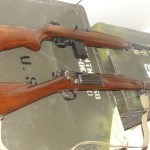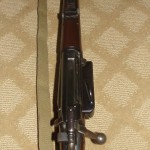I’ll have to admit, I’m not really that much into the tactical gun scene. I prefer wood and metal and revolvers. I’ve never really been attracted to AR’s with all the gadgets and doodads stuck all over the things. Give me iron sights and some nice looking wood. Now I do have a Glock and it is fun to shoot, but I’m still drawn to my Smith & Wesson model 10 revolver.
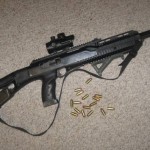 Which brings me to the topic of the day – my recent purchase that has been dubbed “the zombie gun” (I’ll explain later).
Which brings me to the topic of the day – my recent purchase that has been dubbed “the zombie gun” (I’ll explain later).
I first heard of these pistol round carbines while perusing one of the firearms forums that I frequent. Reading through the various threads and hearing the guys talk about how much fun they were, I was intrigued. Especially when I found out how inexpensive they were. Plus, some guy even took a wild hog with one! How cool is that?
So here it is, my Hi-Point 4095 carbine in 40 S&W. And yes, I’ve put some gadgets and doodads on it. The thing is so economical that you actually have money left over to put gadgets on it, so why not?
I haven’t had a chance to finish siting in the red dot yet, but my first impression of the rifle is great. It shoots great and feels great. The trigger is very nice, much nicer than I expected it to be. It pulls up well into the shoulder. Hi-Point has blown me away with this gun. I can see why everyone loves the heck out of it.
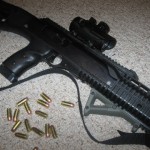 OK, so let me get into why I call it the Zombie Gun. I love me a good zombie movie (and not all of them are) and one day I ran across some articles where gun owners were discussing which gun would be the best gun to have when the zombies show up. Alright, cool. But Keith and I talked one day and decided we’d write a zombie gun article some day also. But our spin would not be which gun we wish we had, but what would we grab from what we own to take on the hordes of the undead.
OK, so let me get into why I call it the Zombie Gun. I love me a good zombie movie (and not all of them are) and one day I ran across some articles where gun owners were discussing which gun would be the best gun to have when the zombies show up. Alright, cool. But Keith and I talked one day and decided we’d write a zombie gun article some day also. But our spin would not be which gun we wish we had, but what would we grab from what we own to take on the hordes of the undead.
So here’s my article and why this would be my zombie gun (and hence why it has that nickname now).
So I thought of the firearms I have and which would be better. Of course, the plains rifle is out. A muzzle loader is just going to get your brains feasted on. So its out by default. The shotgun would be good for close range, but not much help long distance wise. Plus carrying enough ammo would be heavy. The pistols, as well, only good for close range. One of them would be the backup.
So that left the Marlins. I’d probably pass the scoped one by as it would just be too cumbersome. No help in close range and too easy to knock out of alignment. You know, you’re running and moving a lot, staying ahead of the undead.
So that leaves a Marlin 336 in 30-30 with iron sights and the new carbine.
Both are light and maneuverable. Both would be good at distances of around 100 yards, although the Marlin would have an edge here as it could poke out further than that. And both would be handy up close.
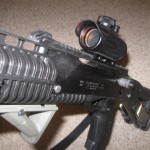 The Hi-Point has an edge in ammo count though. 10 in the mag and 1 in the chamber for the Hi-Point. 6 +1 for the Marlin. With the Hi-Point I can reload with a new magazine. The Marlin I’d have to load individually. So you have to take into account which one would be easier to reload on the move. The hi-Point would have the edge here – that is as long as you have enough mags. So it might end up being a wash in the end. Ammo for both guns should be readily available and easy to find as both are popular calibers.
The Hi-Point has an edge in ammo count though. 10 in the mag and 1 in the chamber for the Hi-Point. 6 +1 for the Marlin. With the Hi-Point I can reload with a new magazine. The Marlin I’d have to load individually. So you have to take into account which one would be easier to reload on the move. The hi-Point would have the edge here – that is as long as you have enough mags. So it might end up being a wash in the end. Ammo for both guns should be readily available and easy to find as both are popular calibers.
But there’s one place where the Hi-Point wins. It shares the same ammo as my Glock. So I only have to carry one caliber. What would totally seal the deal is if the carbine and the Glock shared the same magazine, but that isn’t the case.
I suppose one could say I’d have less chance of jams with the Marlin and the S&W revolver. And that is true, less of a chance for jams. But from what I’m reading, the Hi-Point seems to be a workhorse and can take a lot of abuse. The one unknown is how long any of the guns would shoot when getting really dirty. And most likely, the guns are going to take some serious abuse between cleanings. Think about, lots of running, lots of moving around and staying mobile. There might not be much time to clean the guns.
I really wanted the Marlin and the S&W revolver to win. I really did. It would be to cool taking out the Zombies with a lever action rifle, wearing a big hat and taking names (do zombies have names at that point?). But in the end, I have to go with the carbine and the Glock as a back up. It would just be easier sharing the same ammo in the long run.
So there you go. If the hordes of zombies ever show, I’m ready. I’m curious to see what Keith comes up with on his end.
Keep your powder dry.

